Guidance
- Q4 revenue: $206–$213B; midpoint $209.5B (vs. ~$208.1B cons.) — would mark Amazon’s first‑ever $200B quarter, just five years after topping $100B.
- Q4 operating income: $21–$26B; midpoint $23.5B (vs. ~$23.8B cons.).
- Stock reaction: shares up ~9–10% post‑print.
- Capex: guidance pending on the call (watch for AI/data center commentary).
Segment Highlights (Current Quarter)
- Online stores: $67.14B (vs. $66.94B est.), +8% YoY — core retail showing steady demand.
- North America revenue: $106.3B (beat) — signals resilient domestic consumer and logistics throughput.
- Advertising services: $17.7B (vs. $17.34B est.), +22% YoY — growth rate flat vs. last quarter but remains one of Amazon’s fastest‑growing profit pools.
Why It Matters
- Crossing $200B in a single quarter underscores Amazon’s multi‑engine model: retail flywheel, ads monetization, and cloud.
- Operating income guide is a touch light at midpoint, but leverage from ads and efficiency gains should cushion margins.
- Capex color is key: investors want detail on 2026 spend cadence for AI infrastructure (chips, data centers, power), and expected returns through AWS.
Context: From $100B To $200B In Five Years
Hitting $200B in quarterly revenue cements Amazon’s position as the most diversified scaled consumer‑to‑cloud platform. The ramp from the first $100B quarter to $200B in roughly five years reflects:
- Retail efficiency gains (regionalized fulfillment, same‑day nodes, robotics) that lower cost per delivery and raise conversion.
- Ads scale on high‑intent surfaces (search, product detail pages, streaming video) with improving measurement and self‑serve tools.
- AWS platform breadth—from traditional compute/storage to AI training/inference and data tools—expanding wallet share with existing customers.
Seasonally, Q4 is the company’s peak—Prime deals events bleed into holiday, compressing massive volume into a short window. The revenue bar, therefore, is high by design; execution hinges on fulfillment capacity, last‑mile reliability, and returns processing.
Watch Items On The Call
1) AI/Capex Trajectory: pace of Trainium/TPU deployments, data center timing, and power procurement; any shift to sequenced capex.
2) AWS demand signals: gen‑AI workloads, third‑party ROI wins, and pricing dynamics vs. Nvidia alternatives.
3) Ads durability: signal strength into ’26, retail media competition, and product innovation (search, streaming).
4) Retail margin mix: same‑day/next‑day penetration, regionalization benefits, and cost per delivery trends.
Deep Dive: Retail And Logistics Levers
Amazon’s North America beat suggests the regional fulfillment model continues to pay off. By placing inventory closer to demand and expanding same‑day sites, Amazon reduces middle‑mile costs and shortens delivery promises—both conversion drivers. Key levers to listen for:
- Same‑day/next‑day share of orders and its cost profile vs. 2‑day.
- Robotics and automation penetration in new sites, including automated sortation and fulfillment lanes.
- Returns optimization (box‑free, label‑free drop‑off; AI routing to resale/outlet) to mitigate post‑holiday pressure.
- Third‑party seller health, fees/mix impacts, and buy‑with‑Prime momentum off‑Amazon.
International dynamics matter, too. FX, shipping costs, and local consumer strength can swing margins. While figures weren’t broken out here, management commentary typically frames disciplined investment in regions where delivery speed and Prime adoption can reach North America‑like density.
Deep Dive: Retail And Logistics Levers
Amazon’s logistics edge comes from precision — faster fulfillment, smarter automation, and optimized returns. The next frontier of efficiency lies in robotics, AI routing, and data-informed site strategy. Understanding these levers isn’t just about e-commerce — it’s about the evolving infrastructure of modern supply chains.
Post Jobs & Hire Logistics & Operations Talent →Advertising: Profit Engine And Product Roadmap
At $17.7B and +22% YoY, ads remains a core profit driver. Even with a flat growth rate vs. last quarter, the unit benefits from:
- Rising ad load on high‑intent retail search balanced by relevance safeguards.
- Better attribution/measurement for brands (incrementality studies, MMM integrations).
- Streaming ad inventory via Prime Video and sports rights that extends reach beyond retail surfaces.
- AI‑assisted creative and campaign optimization embedded into self‑serve tools.
Investors will watch for commentary on retail media competition, CPC inflation, and how ad mix shifts impact consumer experience—especially into peak holiday traffic.
AWS And AI: Spend Now, Harvest Later
The pivotal debate is capex. Industrywide, AI infrastructure spend spans chips, data centers, power, and cooling—with multiyear commitments. The Street wants:
- Phasing: how 2026 capex curves compare to 2025 as supply chains normalize.
- Mix: in‑house silicon (Trainium/Inferentia) vs. third‑party GPUs/TPUs; implications for gross margin.
- Demand proof: third‑party workloads with measurable ROI (developer productivity, support deflection, search/ads lift, risk/fraud).
- Power strategy: PPAs, on‑site generation, and grid readiness to avoid stranded capacity.
Clarity here can support multiple expansion even if operating income guidance sits slightly below consensus at the midpoint. Conversely, elevated capex without matching demand signals is a risk to 2026 free cash flow expectations.
Key Takeaway
Amazon’s guide to a $206–$213B Q4 sets up a milestone first $200B quarter. With ads compounding and retail steady, the swing factor is AI capex: clarity on spend vs. returns will drive the 2026 narrative.
FAQs
Is operating income below expectations a red flag?
Slightly light at midpoint; investors will weigh this against ads strength and efficiency tailwinds, plus any capex phasing updates.
What could derail the stock reaction?
Heavier‑than‑expected 2026 capex without matching demand proof, or soft AWS commentary on enterprise AI adoption.
How should investors think about holiday risk?
Carrier capacity, weather, and returns spikes can pressure costs. Offsetting levers include regional inventory placement, automation, and improved reverse‑logistics routing.
Where does ads go from here?
Expect continued retail media depth, more streaming ad products, and AI‑assisted tooling; watch for guidance on signal loss mitigation and measurement partnerships




